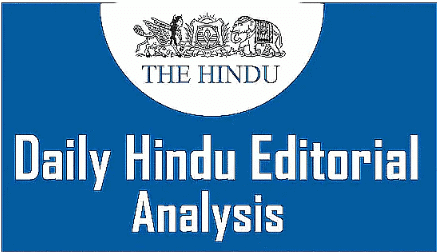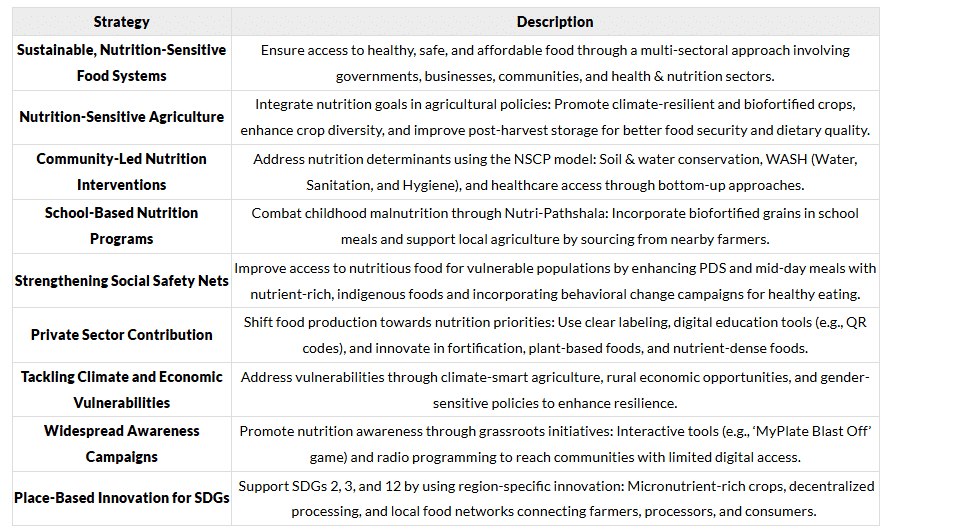The Hindu Editorial Analysis- 10th May 2025 | Current Affairs & Hindu Analysis: Daily, Weekly & Monthly - UPSC PDF Download

Sprouting sustainable, nutrition-sensitive food systems
Why in News?
India's struggle with nutritional issues needs to drive a change, making sure that nutrition is an integral part of agriculture and economic planning.
Introduction
The worldwide food system is facing challenges due to limited resources and climate change, all while trying to keep food accessible and affordable. India, despite being a major producer of milk, fruits, vegetables, grains, and livestock, is confronted with serious nutritional problems, including both undernutrition and overnutrition, along with widespread deficiencies in essential micronutrients. These challenges pose a risk to India’s demographic advantage and economic stability. With a rank of 105 out of 127 countries in the Global Hunger Index 2024, India’s food insecurity calls for immediate action.
Addressing Malnutrition and Food System Challenges in India
Undernutrition in India: The National Family Health Survey (NFHS-5, 2019-21) reveals alarming data:
- Nearly 194 million Indians are undernourished.
- 35.5% of children under five are stunted.
- 32.1% of children under five are underweight.
- 19.3% of children under five suffer from wasting.
Rising Overweight and Obesity: There is a concerning rise in overweight and obesity:
- 24% of women and 22.9% of men are affected by overweight and obesity.
Anaemia in Women:. critical issue is the high prevalence of anaemia:
- 57% of women of reproductive age are anaemic, highlighting the widespread problem of hidden hunger.
Need for a Holistic Strategy: The data underscores the urgent need for a comprehensive strategy to tackle malnutrition in a holistic manner.
Global Impact of Food System Failures: On a global scale, food system failures result in annual costs of nearly $12 trillion due to health, nutrition, and environmental degradation.
India’s Vulnerabilities and Opportunities: Given India's rapid population growth and climate vulnerabilities, an unsustainable trajectory is not viable. However, this crisis presents a powerful opportunity to:
- Transform food systems around nutrition, sustainability, and equity.
- Boost national well-being and support progress towards the Sustainable Development Goals (SDGs).
The Nutrition Challenge as a Perfect Storm
- Food Insecurity Beyond Hunger: Food insecurity now encompasses all forms of malnutrition, including diet-related non-communicable diseases (NCDs), not just hunger.
- Affordability of Healthy Diets:. significant portion of the population, including food producers, cannot afford a healthy diet. The FAO reports that 55.6% of Indians are unable to afford nutritious food.
- Rising Cost of Nutritious Food: The cost of nutritious food has increased from $2.86 per person per day in 2017 to $3.36 (purchasing power parity, PPP) in 2022.
- Structural Flaws in Food Systems: Structural flaws in food systems exacerbate the situation, while climate change poses threats to crop yields, biodiversity, and the livelihoods of small-scale farmers, increasing nutritional vulnerability.
- Impact of Malnutrition: If unaddressed, malnutrition will continue to impede human capital development, escalate health-care costs, and diminish economic productivity.
Transforming Food Systems

Role of Nutrition and Health Communities
The health and nutrition sectors are vital in transforming food systems. Nutritionists, public health experts, and policymakers need to collaborate to integrate nutrition into agriculture and economic planning. Tackling malnutrition and non-communicable diseases (NCDs) requires systemic approaches that address inequality and promote climate resilience. Initiatives like the Nutrition Smart Cities Programme (NSCP) and Nutri-Pathshala highlight the effectiveness of combining nutrition with agriculture, education, and social development.
Conclusion
Gradual changes are insufficient. A radical overhaul of food systems is necessary. Governments need to align policies with nutritional objectives, businesses should embrace sustainable practices, and civil society must advocate for inclusive, community-driven solutions. Nutrition should be the foundation of food systems, economies, and policies. A healthy, well-nourished population is crucial for a resilient and equitable society. The challenge is significant, but the potential is equally vast. Now is the time for action.
It is time to protect India’s workers from the heat
Why in News?
Millions of informal urban workers in India are suffering due to ineffective Heat Action Plans.
Introduction
- In early April 2025, Delhi experienced alarming temperatures exceeding 41°C, with persistently warm nights. This extreme weather has become the new norm, exacerbated by the worsening effects of climate change. Indian cities are increasingly at the forefront of this escalating crisis.
- While heatwaves impact everyone, urban informal workers are disproportionately affected. The Reserve Bank of India (RBI) highlighted in 2024 that extreme heat poses significant risks to health and livelihoods, potentially leading to a 4.5% loss in GDP. Despite their crucial roles and large numbers, these workers are often overlooked in urban heat response plans, resulting in dire consequences.
Key challenges in current Heat Action Plans
- Numerous Indian cities have implemented Heat Action Plans (HAPs), drawing inspiration from Ahmedabad's innovative approach.
- The National Disaster Management Authority (NDMA) guides these plans to address the increasing frequency and intensity of heatwaves.
- However, over a decade later, most HAPs remain superficial, underfunded, and lack proper coordination.
- A recent review indicates that informal workers are mostly excluded or mentioned vaguely (as "outdoor workers" or "vulnerable groups").
- Many HAPs view heatwaves as short-term crises rather than indicators of a broader climate emergency.
- At the State level, HAPs often lack guidelines for occupational safety, hydration, cooling areas, shade, or compensation for lost work.
- City-level HAPs typically prioritize public health and awareness, overlooking the impact on livelihoods.
- Governance remains disjointed, with ministries such as Labour, Environment, Urban Affairs, and Health operating independently without centralized coordination.
- Most city HAPs function as temporary measures for summer, lacking long-term strategies like urban cooling, heat-resilient infrastructure, or worker protections.
International and Indian Best Practices for Worker Protection
Region/Country
- Worker Protection Measures
- Ahmedabad, India
- Adjusted working hours; shaded rest areas
- Odisha, India
- Mandated halt to outdoor work during peak hours
- California & Oregon, USA
- Employers must provide water, shade, rest breaks, and heat safety training
- France (Plan Canicule)
- Requires work adjustments, hydration during alerts, and opening of public cooling spaces
- Qatar & Australia
- Outdoor work restricted during peak heat; employers must assess and mitigate heat risks
Key Elements for a Worker-Centric Urban Heat Response
- A new urban heat response is urgently needed — worker-centred, just, and rooted in lived realities.
- NDMA’s 2019 Heat Guidelines must be updated to explicitly include informal workers.
- Framework should map occupational vulnerabilities for diverse groups:
- Construction workers, street vendors, waste pickers, gig workers, rickshaw pullers
- Include actionable protocols:
- Safe working hours, mandatory rest breaks, water access, emergency response mechanisms
- Worker participation in HAPs must be mandated at city and State levels.
- Top-down planning must shift to co-creation with:
- Worker collectives, unions, welfare boards, civil society, community groups
- Recognize workers’ right to shade, rest, and cooling in public and workspaces.
- Develop shaded rest zones, hydration points, and cooling centres in:
- Markets, transport hubs, labour chowks, construction sites, public buildings
- Ensure these are accessible, gender-sensitive, and co-managed by workers and communities.
- Institutionalise protections via norms, guidelines, and dedicated budgets.
- Enable innovative financing:
- Use CSR funds, city budgets, and health insurance expansion for heat-related illnesses
- Promote community contributions in action plans.
- Scale up cool roofs, shaded walkways, and passive ventilation from pilots to standard practices.
Recommended Action Areas

As a part of city design and governance
- Embed heat resilience and worker safety into city design and governance.
- Integrate climate adaptation and worker inclusion into:
- Master plans, building bye-laws, infrastructure codes
- Promote natural shade through:
- Urban forests, tree corridors
- Plan blue networks including:
- Water bodies, public resting spaces
- Retrofit informal workspaces (e.g., vendor markets, waste depots, labour chowks) for thermal comfort using climate-resilient materials and design.
National Coordination and Institutional Mechanisms
- Establish an inter-ministerial task force on climate and work at the national level.
- Include ministries:
- Labour and Employment
- Housing and Urban Affairs
- Environment, Forest and Climate Change
- Health and Family Welfare
- NDMA and State Disaster Management Authorities (SDMAs)
- Develop an integrated road map linking:
- Climate resilience, worker protection, and labour codes
- The task force must:
- Guide cities, coordinate inter-agency efforts, and ensure accountability
- Appoint a dedicated heat officer in every city and district to:
- Monitor heat response, manage implementation, and work across departments
Institutional and Governance Interventions
- Governance Level
- Key Actions
- City Planning
- Include heat safety in master plans, bye-laws, and infrastructure standards
- Urban Greening
- Expand tree corridors, create urban forests, integrate water bodies and rest areas
- Informal Workspaces
- Retrofit with climate-resilient designs to improve thermal comfort
- National Coordination
- Form inter-ministerial task force linking climate policy and labour rights
- Local Implementation
- Appoint heat officers to manage response, coordinate departments, and ensure accountability
Conclusion
For informal workers, the climate crisis is not a future problem — it is a daily reality. The cost of doing nothing is no longer just about rising temperatures — it is about lost lives, lost livelihoods, poor health, and uncertain futures.
|
38 videos|5288 docs|1117 tests
|
FAQs on The Hindu Editorial Analysis- 10th May 2025 - Current Affairs & Hindu Analysis: Daily, Weekly & Monthly - UPSC
| 1. What are sustainable, nutrition-sensitive food systems? |  |
| 2. How does climate change affect workers in India, particularly in agriculture? |  |
| 3. What measures can be taken to protect Indian workers from extreme heat? |  |
| 4. Why is it important to focus on nutrition-sensitive food systems in India? |  |
| 5. What role do government policies play in promoting sustainable food systems in India? |  |
















